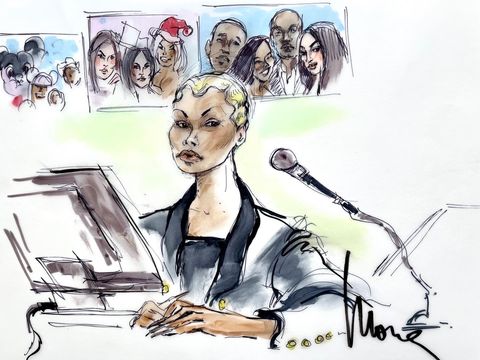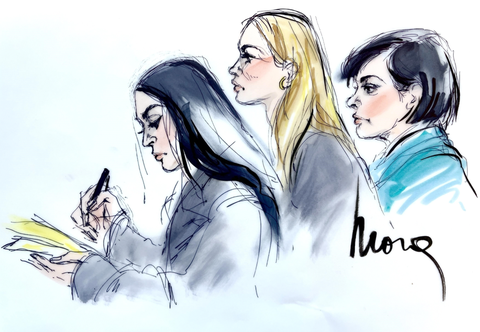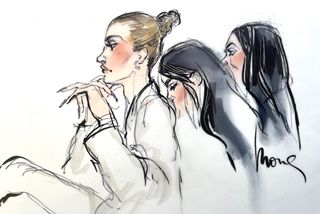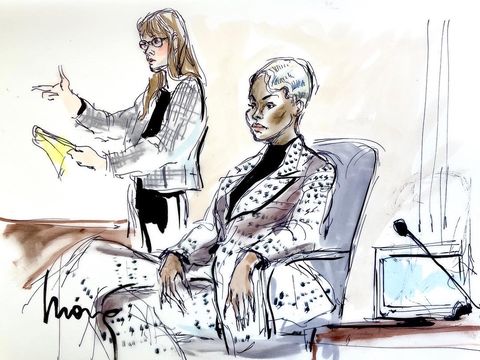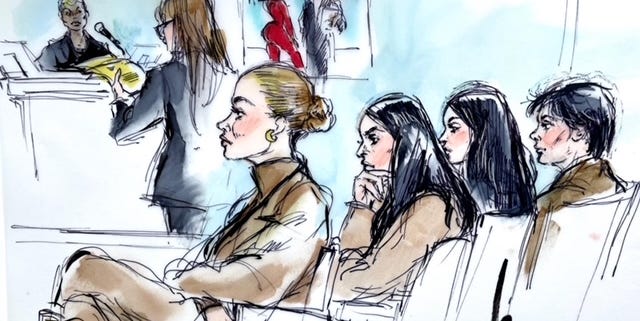
Kardashian-Blac Chyna Trial Artist Mona Shafer Edwards on Drawing in Court
Working as a courtroom artist, Mona Shafer Edwards says, is about capturing the essence of the people in the room. “My work is emotional,” Edwards tells Town & Country from her home in California. “It’s fluid; it’s alive. The best work I do is really fast, where I’m working from an emotional point rather than [an] analytical one.”
Edwards, who began her career as a fashion illustrator, draws all sorts of trials—from murder cases with no press to celebrity disputes with immense interest and scrutiny. She’s currently making headlines—and going viral on social media—for her artistic renderings of the Los Angeles trial in which Blac Chyna is suing members of the Kardashian family (specifically Kris Jenner and her daughters Kylie Jenner, Khloé Kardashian, and Kim Kardashian), accusing them of defamation and contract interference.
Edwards doesn’t mind the attention; drawing the Kardashians, and other celebrity trials, is a fun change of pace from her normal work. “I do horrible murder trials, child torture, and life and death issues,” she says. “When I do these kind of cases that are just about money, how does one have the same concept of true justice? It’s a hundred million dollar lawsuit against people with hundreds and hundreds of millions of dollars. All of the characters involved are very animated figures.”
Before she headed off to Los Angeles court Friday morning to draw Kris Jenner’s testimony, Edwards spoke with T&C about drawing the Kardashian-Blac Chyna trial, the future of courtroom art, and why Elon Musk was one of the hardest people she’s ever had to draw.
It seems like the entire internet is talking about your drawings of the Kardashian-Blac Chyna trial.
It’s all about fashion and style! Any the cases that I do that are celebrity driven, it is all about the clothes. I’m watching reporters taking down furious notes when the Kardashians come walking in, cause [the Kardashians] all seem to be in sync with what they’re going wear every day. As with all these other Hollywood trials, the focus is on the hair and the makeup. So I focus on that, too, because that’s what people wanna see.
Do you think the fashion and style have contributed to your drawings going viral?
I can’t control what people write, but there was a viral storm the other day with the sketches. It was a full courtroom, and I was placed like seven rows back of the Kardashians, but I had a great view for Blac Chyna. And a British website did a really bizarre story saying that the Kardashians wanna sue the sketch artist. I couldn’t believe it because it’s just not true. In all my years of covering greater celebrities, bigger [more famous] people, I’ve never even heard that. Of course, with everything, it blows over very quickly because people are pretty fickle. But it has been a weird experience because the Kardashians polarize so many people.
How has that polarization impacted this trial?
They have great fans and great haters. Watching the jury selection, it was embarrassing. People were incredibly open as far as their attitudes towards the Kardashian family. Years ago, you would’ve never heard people giving an opinion like that, but they just didn’t really wanna be on the jury. And then some people really wanted to be on the jury! It’s an interesting study on social history.
What has your experience been like drawing the trial with all this attention?
It’s been a great flurry. [The conservatorship hearing of] Britney Spears had somewhat the same feeling, except Britney Spears has a totally different fanbase; her fans took over the whole street in front of the courthouse. There were parades. It was very boisterous and colorful, everything was pink! But this, there are very few members of the public waiting to get into this. It’s more about the aura that the Kardashians have, rather than necessarily watching the trial.
When you’re drawing them, how do you capture that aura?
I’m a fashion illustrator, that’s how I started. I’m really fast and I have a bit of a photographic memory—I did a lot of runway [drawings], so I have to be able to get an image imprinted in my mind very quickly. And of course, I know how the body works and how clothes fit and move. [The Kardashians] are very recognizable, so that makes my work more difficult.
Because everyone has a vision of what they look like?
Well, everyone has a vision of what is put out there for them. When I see a celebrity in court, it’s not filtered or airbrushed. A couple days, Kim Kardashian was not wearing a lot of makeup, and she looked very different.
It’s really hard for an illustrator to determine what would be a courtroom illustration, and what some would perceive as a cartoon or a caricature. When someone is so famous and you recognize them, it’s very hard—unless someone is a portrait artist—to capture that in a few minutes.
I remember drawing Alec Baldwin once, years ago when he was married to Kim Basinger, and he was a witness. When he was on the stand, every inch that he would turn his head, he looked totally different! It was the strangest experience, I just couldn’t get him. With Elon Musk, too, he was one of the hardest people I’ve ever drawn, he looked different in each pose.
How does your perception of the case or the person impact how you draw?
I try to be incredibly objective. It’s not my place to have an opinion; I never express an opinion. I listen, I don’t make any judgements. Some people are more fun to draw, some people say things sometimes that are more shocking than others, but I try and give everybody the same treatment. Sometimes it’s really hard when there’s a murderer, and I’m listening to victim impact statements. It’s really hard to give that person the same benefit as I would to somebody else. But that’s my job.
Has anyone ever reached out to you after you’ve drawn them?
Oh, yeah. I got an email from Christian Louboutin. Lindsay Lohan was wearing a pair of his shoes when she was arrested. When she turned around, there was the red sole of the shoe, that was the moment I chose—with that fire engine red sole. And I got a note saying that it was great to see his shoes.
I’m thankful that I haven’t gotten any nasty notes. People like being drawn. They like being sketched, it’s a very intimate thing, more than being photographed. Sometimes, I feel like they’re posing for me; it’s a weird sensation, they know that I know that they’re being drawn.
It’s not like being photographed at all.
No, no, photography is the camera in your face. When someone is looking at you and then sketching, looking at you and then sketching, it’s more of a visual dance.
Usually people look better when they’re in the magazines and TV. I was struck by one person who looked so much better in real life: Catherine Zeta-Jones. It was a stalking case [in 2004], and when she was on the stand and I remember thinking, wow, she is so much better in real life than in photographs. Sometimes, there are surprises.
Over your years working as a courtroom artist, what have been some of the most memorable moments?
I’ve been scared. I was sketching Whitey Bulger, and he was staring at me. And he wagged his finger at me, like, be careful. And then with his handcuffed hands, he put up some papers in front of his face so I couldn’t see him anymore. Richard Ramirez, the ‘Walk-in Killer,’ he was the personification of evil. He kept California really terrified. When he was in court, he was very handsome and his teeth were all rotted. He turned around at looked at me and smiled, it was terrifying.
What do you think people don’t know about courtroom artists?
They have no perception of how specialized a field it is; it’s not a matter of having a day or a week to do an illustration. It’s a matter of minutes. People have no concept of what it takes to create a story on the paper in just a few minutes that can tell a story. I wish people would realize that it is a very specific kind of a job that a courtroom artist does: It’s a storyteller in, in miniature, in abbreviated time. It’s a lot of pressure and that’s why there’s very few of us.
Now in New York, you have a really different style.
Versus the California style?
Oh, yeah. I see New York artists, it’s much heavier, lot of pastel, darker. Lots of interiors of a courtroom. And if you see mine, I put very little effort into the court. I mean, we know it’s a courtroom atmosphere. It’s more about the people than the landscape.
Where do you see the future of courtroom art going?
I didn’t see a future 20-something years ago. When it was OJ and court TV had just started and he was letting the cameras cover the trial gavel to the gavel, I thought, ‘okay, that was fun, good ride!’
And here we are, and I’m busier than I was a decade ago. When I feel that I can’t do a good enough job, then I will walk away and do my watercolors or fashion again. But for the meantime, I really love it. It’s a big part of what I do, and I get to see things that people don’t see.
This content is created and maintained by a third party, and imported onto this page to help users provide their email addresses. You may be able to find more information about this and similar content at piano.io

